Heroes in Charlottesville - the men boys look up to
Heroes in Charlottesville
The men boys look up to
Photo by Deia Schlosberg
Virginia and Violence
I found myself in Charlottesville, Virginia on August 12th (4 days ago as I begin to write this), following a potential character for the documentary film my partner and fiancée Deia and I are producing. Our subject was there as a counter-protester to confront the various neo-Nazis, klansmen, white supremacists, et al. who were assembling there for the “Unite the Right” rally to protest the planned removal of Confederate General Robert E. Lee’s statue in former Lee Park, recently renamed Emancipation Park.
These white nationalists, as they often label themselves, are in their minds protecting their white American culture and heritage. They see present day America as seeking not only to leave them behind, but to wipe them out completely. They chant “YOU WILL NOT REPLACE US!” They arm themselves and put on their scariest war faces and prepare to do battle with what they perceive as a serious threat to their way of life. Their long term goal is an ethno-state, an exclusively white homeland. They want an America for whites only.
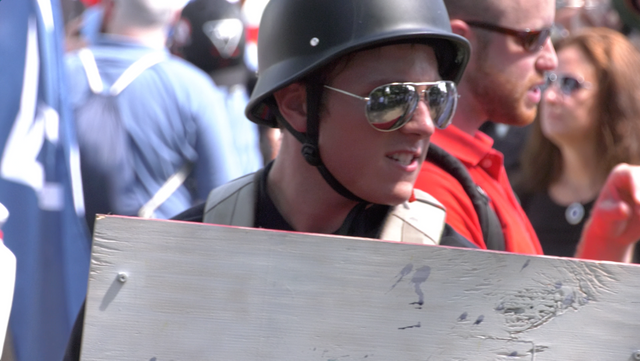
Photo by Deia Schlosberg
The counter-protesters arm themselves for the same battlefield, since the premise of a white “homeland” and such manner of protecting “white freedoms” necessitates at minimum the violent expulsion of millions of innocent Americans. It is a deluded and dangerous point of view, and, to many well-meaning individuals, it seems obvious that it must be violently opposed before it can do serious harm.
This sort of common sense dictates that if an oppressive force rises up and threatens our freedoms and values, we have to be able to rise up and righteously beat it back down. It maintains that if all diplomacy and reasoning fail, we simply need to be stronger and enforce what we know is right, that we have to make the retribution for wrongdoing so painful that the problem won’t dare raise its head again. Love is wonderful and words are nice and all that, but some people only respond to physical power, after all.
This smackdown mentality pervades our simplistic national consciousness. We’re incited often to crush our enemies in the name of causes of varying morality. You can see it on the left and among progressives as well, and it remains, in my view, an unhealthy and unproductive response to threats. Of course, punching a Nazi and advocating the full scale national expulsion of people with different skin color are not on the same level of violence or in the same universe of morality in any way, but both attitudes do seem to lead to violence and escalation. What’s more, I do agree that strength and unity against hatred should be shown through a large and vocal presence at these events, but the weapons with which we arm ourselves should be rooted in love and peace.
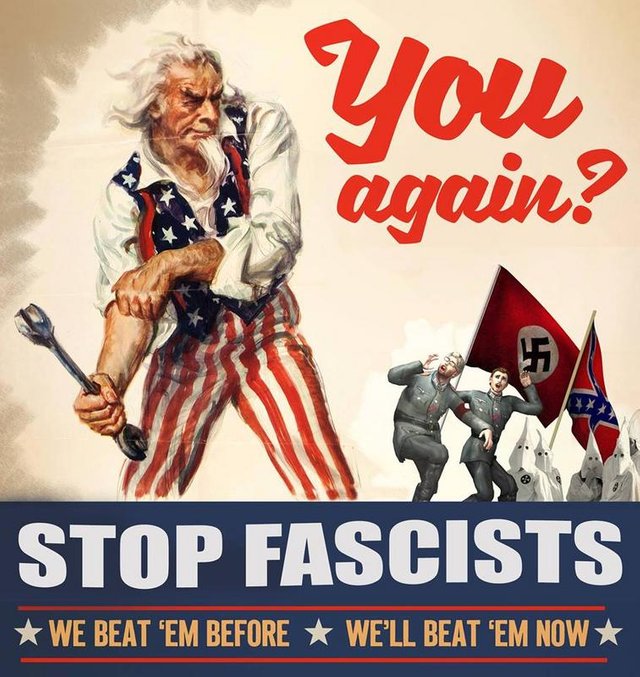
It may be difficult, but imagine you’re even mildly sympathetic to a white nationalist group for whatever reason. How do you think you would react to this image? Would you change your ways or raise your defenses?
But why even get involved in the madness at all? It is because inaction does not lead to change. Those who simply condemn violence on all sides while not adding their strength behind a solution of some kind are being intellectually dishonest. If we don’t actually invest ourselves in addressing the issue, then our judgment of what goes on in the street is inappropriate, even hypocritical, because our decision to remain uninvolved, to just remove ourselves from the problem, is a degree of tacit participation in the status quo injustice and danger the oppressed are fighting against. Those who are physically present at the rallies, linking arms, peacefully demonstrating for tolerance and love, and those who spend actual time and energy advocating for real legislation, are at least working to create actual change. They’re presenting an alternative. If every American took action and got their feet in the street or at city council meetings rather than just waiting it out, then violent anti-fascist groups likely wouldn’t feel the need to rise up in the first place. If we’re not in some way actively involved in forwarding a solution, then we’re part of the problem, and the blame lies partially with each of us. Apathy and patience are not luxuries in which the hated and oppressed can afford to indulge, because they face very real danger in their lives.
Some would argue that nonviolent action is similarly unaffordable, but I would insist that what makes it different is that nonviolent action in its many forms is still action. Anything not active, however, is inaction, and is a form of violence. Simply sitting at home disapprovingly is nonparticipation, which is inherently violent in that it supports the violently unjust status quo.
And why must the actions we take remain nonviolent? In this brave new world of instant and ubiquitous media attention, both mainstream and independent, not only is it much more morally palatable at face value to avoid causing human beings direct physical harm, but I will also insist that it is much more effective because of that constant media presence. Inclusion and love are the winning strategies, because they so clearly occupy the high ground, and thus it is so much harder for viewers of any affiliation to find fault with them. Gone are the days of squashing uprisings, eradicating dissidents, and bringing one’s enemies to heel. The world is watching 24–7 now, and we have to be mindful of our actions as marketing decisions representing our individual and collective morals. Whoever resorts to violence is the loser of the moment. That is why white nationalist groups publicly proclaim that they are only trying to advocate free speech. They assert that they love and respect everyone, and that they only seek to protect themselves and their ways. They are keenly aware that a victim is far more powerful than a tyrant, vulnerability more effective than force. The leaders of these movements often explicitly express this as strategy. They are quick to cry tears on camera about the repression of their freedoms as well as about any retaliation, but they urge their followers to incite anger and violence as much as possible. They want to get punched. Being assaulted by groups of masked vigilantes feeds their power.
The most effective tool we have in this day and age is the sympathetic attention of the masses. Dr. Martin Luther King Jr. knew very well that we cannot, as individuals, beat back oppression. The only weapon that matters is public opinion. The only strategy that has long term potential is the most courageous one: we must trust in the goodness and human nature of others as a rule, regardless of their affiliations. We must call out to our enemies and embrace them, and if they accept our embrace, we all win. If they become violent, they lose. It’s why Standing Rock has become so successful in waking the conscience of the nation. The indigenous groups protesting the Dakota Access Pipeline led an inspiring and brilliant campaign with strict messaging of solidarity and nonviolence. Victory requires the winning of hearts, and the only key to a heart is love.
In practice, it’s a straightforward public relations equation. Here are a few examples I witnessed in Charlottesville:
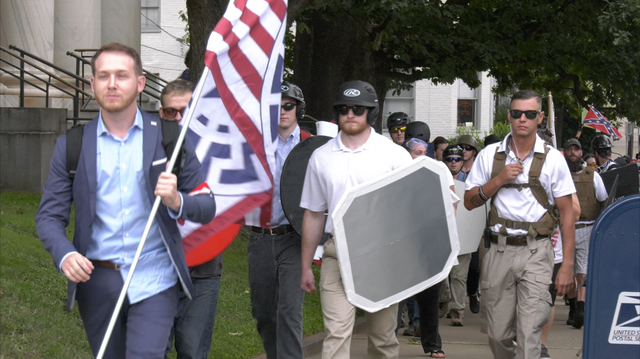
Photo by Deia Schlosberg
- When a group of boys and men sporting khakis, polos, sneers, helmeted skinheads or Nazi hairdos, aviator sunglasses, and swaggering puffed out chests march in like an invading force, carrying ridiculous shields and weapons, picking fights, spitting, throwing cement-filled coke cans, and making jokes about how many “kikes can fit in an oven,” they lose credibility.
- When a fuming Antifa counterprotester brandishes an aluminum bat, slamming it on the asphalt as the group walks by as if to demonstrate the ease with which he can dent skulls, the white supremacy movement gains some validation.
- When even one person punches one supremacist, that supremacist’s immorality is negated or more easily overlooked in the eyes of somebody watching. It doesn’t matter that the vast majority of counter-protesters were singing peace and love. That punch is the message used to recruit another racist or sympathizer.
- When the self-proclaimed peaceful minority group (the white nationalists) request and obtain the presence of an army of militiamen to stand the perimeters among the counter-protesters sporting combat fatigues and semi-automatic rifles in the name of protecting free speech, they reveal their true notion of peace for all to see.
- When members of the counter-protest crowd chant “Death to Nazi scum!” and one of them runs up and pepper sprays a few of the white supremacists point blank in the face, those white supremacists gain support.
- When a seriously disturbed individual (possibly with the coordination and assistance of other seriously disturbed individuals) named James Fields Jr. accelerated his Dodge Charger into a crowd of peacefully marching counter-protesters later that day, he sought to inflict maximum damage. He succeeded. This was actually one of the greatest blows to white nationalist hate groups in a long time. They lost all of their victimhood and credibility in that moment. Notice how fast Vanguard America attempted to disavow all association with Fields. Witness the immediate public backlash. Observe how quickly alt-right figurehead Steve Bannon lost his job in the White House.
Up Close
I feel the need to explain something more personal now. I fear I am mostly coming across as callous and calculating, concerned more with numbers and marketing strategies than with the human beings whose lives were mangled or lost on Saturday. It is very much not the case that I am insensitive to this tragic loss of life. Perhaps I am somewhat numbed to it, or maybe raw is a more accurate word. I think I’ve been refraining from addressing it so far, because I was about 10 feet to the left of counting myself one of the victims bleeding on the pavement, and it’s hard to revisit.
Deia and I were in the crowd looking for our film subject and had just stepped over to the less populated sidewalk to make up some time, because we thought he was up ahead of us. We turned left off of Water Street onto the narrower 4th Street and fiddled with our cameras, turning them on again to get a little more footage of the celebratory crowd all bunched up in this street the way they were.
Then erupted the sound like an explosion of heavy hail on metal as dozens of shattering shins hit front bumper, bodies flying and twisting in the upward and rightward direction, then a smash as the Charger slammed into the cars in front of it. I never even saw the Charger except for a glimpse through the spaces between bodies suspended in air. I would guess about one full second had elapsed between revelry and utter chaos.
Dazed, I tried to decipher the madness I was seeing. My camera continued recording. That a car had hit us was all I could manage to think before hearing the “Pop! Pop!” of what sounded like gunshots. Fearing that someone, either the driver or an ensuing confederate, was now on foot to execute us, I ducked behind a parked black pickup truck. At this point I remembered Deia and looked back behind me to my right to check in with her and figure out together how to escape this. She wasn’t there.
The Charger peeled away in reverse and the gun shot sounds stopped. I didn’t register much of this, though, because I was just crouching there behind the Toyota Tundra, working up the courage to stand again, trying desperately to locate the love of my life, my Sweet Potato, among the swarming crowd and the sprawling and bleeding bodies there on the sidewalk where I’d last seen her. She had been right next to me! There was no way she’d been hit, I tried to assure myself. How could I have lost sight of her?
It turns out Deia had run in the other direction, around the corner and across Water Street. For the next two or so minutes, though, after it seemed the threat of gun violence had lessened, I frantically scoured the area, going back by the injured for a closer look, searching for her. About 50% of my awareness was checking for new threats. I kept on filming as I skitted about the madness. I didn’t know if I was still recording out of a sense of obligation to document the story, but I couldn’t shake a sense of duty to help the people I saw wretched before me. I didn’t help them, however. A young woman sat upright on the asphalt, bawling, looking up at me with two legs broken so badly they looked like noodles. I filmed her for an instant and kept moving. Another dazed young woman sat a few feet beyond, blood streaming down her face, reaching out in front of her to try to get a grip on the air itself. I stepped past her. A crowd of panicked medics had gathered around a woman named Heather, who was lying supine, lifeless, by the curb. They were trying to revive her. I filmed for a half second as I confirmed for myself that her face was not one I recognized. I noticed a cell phone on the ground and picked it up. I saw blood on my hand, not my own. I spun around and started screaming Deia’s name as people rushed past me to help the victims. I waded through them. About a minute later, my sweetheart found me and rushed to me and it felt like the first time I’d taken a breath in an hour. She was shaking badly. We moved down the street away from the scene of the accident, fleeing, cameras still recording, though no longer intentionally filming anything, and walked briskly into the parking garage our car was in, the one overlooking the scene of the attack. We looked down on the scene from the second level for a minute until the owner or attendant of the garage said that we had about 10 minutes to leave before she closed and locked the gates early to get away from the area herself. We hurried back to our tiny black Honda fit bedecked with its “Save the Bees!” and other such bumper stickers. I dropped to my belly and checked the undercarriage for bombs as if I was Jason Bourne, as if I’d know what a bomb would look like. We got in and drove. I babbled something incoherent about a grey car to the armed men standing guard at the exit. We turned left, away from the crowd, and I stepped on the gas.
Within about a mile, the world had no idea what had just happened. People walked their dogs through a pleasant suburbia.
The police and the New York Times described the attack as if Fields’ Charger had hit a sedan into a minivan, and then that minivan had hit some people, and some people were injured, and one person died. That isn’t how it happened. The sedan and minivan were likely not even visible to the speeding young James due to the crowd of protesters tightly packed in the street between him and them. He accelerated into the crowd of people. He mowed them down until he hit an object too large to drive through. It is amazing to me that more people didn’t die. Without those cars in his path, I doubt he would have stopped at all. I suspect he would have sped on through the crowd until he was watching the bodies recede in his rear view mirror. I later figured out from the footage that the gun shots I’d thought I’d heard were caused by the baseball bats of counter-protesters who had run up and begun hitting Fields’ car after it crashed.
WARNING: GRAPHIC CONTENT. For a chaotic first-hand view of what I saw, here is the unedited, shaky footage of the accident captured on my GoPro.
That’s basically how it went down from my vantage point. Some of my memory was aided by our footage. Deia and I were about as close as anyone could be without being hurt, but we’re 100% physically fine except for the general soreness that I’m discovering comes with such an emotional trauma. Everything seems to ache.
What is Best in Life? — Examining the mind of the Supermale
I’d like to digress for a bit. As a way to try and understand these events, I’ve found my self falling back on a more comfortable area of expertise: that of a film nerd. Please bear with me if you’re not so into testosterone films and understand that I’m writing this in an attempt to provide a lens into the psyche of today’s Gen-X/millennial man-boy demographic, of which I am a member. It must be acknowledged that our cadre make up a significant portion of these movements and counter-movements, of this nation itself, and that we are going to help shape the future for better or for worse, so it’s best we be understood in our motivations and mental states.
As a quick qualifying statement, I recognize that the characteristics I’m about to lay out are not exclusively or universally male or white or confined to within a generation or two, but they are primarily male, they affect a very significant percentage of males to varying degrees, and the Gen-X and millennial Caucasian-American sort are the ones I understand most intimately.
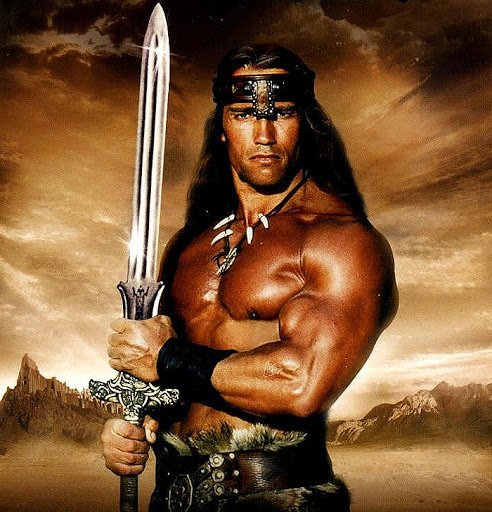
Conan of Cimmeria
In the movie Conan the Barbarian (1982), Arnold Schwarzenegger plays a man who saw his family executed in front of him as a boy, a man who then grew up and grew strong under conditions of slavery and brutal manual labor that most who suffered with him did not survive. Conan’s people had been conquered, and his family murdered, for the valuable resource of steel. He spent years chained to the Wheel of Pain, a giant mill designed to be powered by the march and push of many laborers. As his fellow wheel-pushers gradually died off and disappeared over the years, young Conan simply grew stronger and bore the extra load himself until he looked like, well, Arnold Schwarzenegger in the 80s, driving the mill alone. Eventually, Conan’s tremendous size and strength made him an appealing candidate for the fighting arena, and he was taken from the wheel and promoted to gladiator. He was still a slave, but now he was rewarded for victory with women and luxury along with, naturally, the privilege to keep on living. After surviving his first few fights and showing great promise, he was further educated in the ways of battle by his masters.
At one point, his wise old trainer asks him, “Conan, what is best in life?” He answers to immediate approval: “To crush your enemies, to see them driven before you, and to hear the lamentations of the women.” I can’t express how badass this was to me. He goes on to earn his freedom, exact revenge on the powerful cult who killed his family, and, in time, become a king himself, wise and just.
I was a young boy at the time, and you’d have been hard-pressed to find a movie that spoke to me more deeply. Conan was the ultimate hero, followed perhaps by Arnold again in the movie Predator and Van Damme in Lionheart. You see, kids are mostly powerless, and so the idea of just getting so damn buff that you can physically overcome all of your oppressors in life can be endlessly appealing. Just think, with enough weight lifting and skill with weapons, we can achieve justice through sheer physical power. We can crush our enemies.
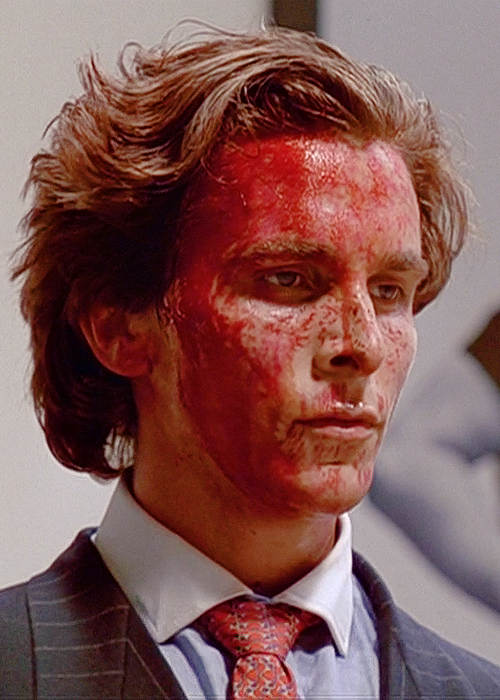
Patrick Bateman
American Psycho, released in 2000 and based on the book by Bret Easton Ellis, presented a different kind of hero. Impeccably dressed, sharply intelligent, wildly successful in the financial sense, and impossibly chiseled, Patrick Bateman served as a role model to many young men more of the college age. He could do whatever he wanted. He could have whatever woman he desired. Nothing was unattainable. However, Bateman was also a mass-murdering psychopath, vain, violent, misogynistic, lost, and what he wanted was to torture and kill. He even got away with it. He was a Wall Street banker who had ostensibly done everything right, societally speaking. He had spent vast amounts of time and dedication becoming erudite on all matters conversational; perfecting his wardrobe, grooming, and business card design; and of course doing thousands of crunches in order to elevate himself to ultimate power and dominance. Many young men, seeing that movie, thought “I’d love to be just like him, except for the psychotic murderer part. What if I could be the kind and giving version of Patrick Bateman, ripped and rich and smart and a good guy?”
Of course, Bateman was never intended to be a hero by his creators, but rather an indictment of a societal sickness. He became a hero to many regardless.
There are countless such “heroes” in movies (heretofore referenced without quotation marks, but always meant to be taken in the same spirit). Many youthful males were impressed by the raw charisma of Edward Norton’s white supremacist Derek in American History X, the brash sexuality and leadership of Brad Pitt’s Tyler Durden in Fight Club, or the brute toughness and intelligence of Robert Deniro’s Max Cady in Cape Fear, and in every case their six pack stomachs. The list of these heroes is long, from the vengeful fathers to the charming murderers to the noble superheroes.
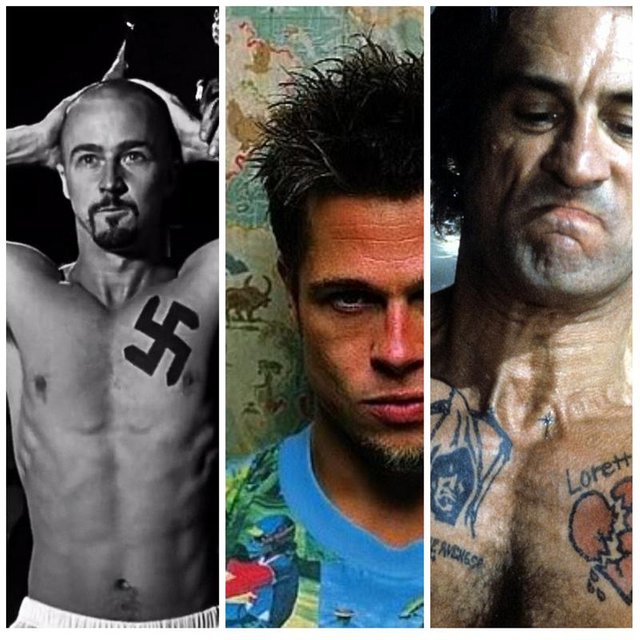
Derek, Tyler, and Max
To be clear, I don’t believe that movies are the root cause of this type of hero worship, but rather a spotlight upon it. They illuminate the simplistic mechanics of a juvenile mind. The problem is that these very impressionable, predominantly male minds are often the ones that miss the point entirely. I know, because I’m one of them. I’m not the hard core type, and I aspire to be more of a Batman than a Bateman in my fantasies, but I deeply long for that self-made power to transcend all obstacles through sheer force of intelligence, muscle, and will. It’s in my bones still, this hammered-in psychology. I’ve watched video clips on how to disarm guns and knives from attackers and actually practiced the motions at home. I daydream about taking out armed hijackers on the subway or wrestling a mountain lion without getting eviscerated. I don’t actually expect to wear a cape and mask some day, and I don’t want to give the impression that I spend very much of my time thinking about such things, but let’s just say I feel compelled to do a lot of push-ups after watching certain movies. I know that I am not alone in this.The events in Charlottesville, and the non-stop news coverage since, have brought these filmic heroes back into my mind.
A Heavy Feeling
Something has been nagging at me since the attack, and I just today figured out what it is. I didn’t help anyone. I didn’t save the day. For all my damned push-ups, I had managed to crouch, panic, film, misinterpret, administer zero assistance to any of the injured, maybe blink a few times, flounder around in the crowd until Deia found me, and then flee. I was not Captain America. I was not Indiana Jones nor John McClane. I was just a scared guy trying to protect myself and find my girl.
I have been carrying the guilt of not living up to my heroic expectations and aspirations since that afternoon. I want to be chided by the dazed girl who just needed someone to help her get off the ground. I want to apologize to the woman with the floppy, shattered legs. I wonder what it must have been like for her to look up and see me stop for a second, point my little GoPro camera at her, and then move on.
Deia has reminded me that there was nothing more I really could have done, that we were directly in the midst of the attack and completely disoriented, that people did rush in to help from around the corner, that that was their role as the fresh eyes who could still survey the situation with some semblance of calm. I know all of this intellectually, but I haven’t been able to fully forgive myself anyway. It was when Deia showed me a moment in the footage when I did, in fact, reach an arm out to try and get a girl next to me to crouch behind the truck with me, when I thought we were about to be shot, that I cried. Deia had pored through everything, frame by frame, trying to understand exactly what had happened, and had noticed in one fraction of a second that my camera had caught the reflection of me in the side panel of the black Tundra, my hand on the girl’s shoulder protectively before she moved away from me. This infinitesimal act of heroism, or of at least some concern for and protection of a human being other than myself, meant more to me than I could have guessed.
I know that it’s irrational and unfair to beat myself up. As I expressed earlier, I’ve long been of the opinion that individuals don’t have the power to effect massive change alone, that it’s public sentiment that matters. It’s movements that count. However, the supermale hero-worship resides somewhere deep within my character nonetheless, and so it still stings to have what I’ve argued intellectually be so viscerally shown to me through this experience, to feel in my bones that I am individually powerless in the midst of the larger forces at play.
Every person, Nazi or neo-confederate, Antifa or Black Bloc, Peace Corps or police officer, CEO or manual laborer, is a hero or a victim in their own story.
Each emulates their idols. I wonder who James Fields Jr.’s heroes are.
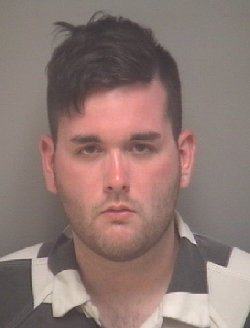
James Fields Jr. — mug shot
Whack-a-mole
Where does this bring us if we hope to make progress and create a better world? Clearly, we can’t wait for a superhero to save the day. Maybe a charismatic and competent politician can do it for us? Nope, not without our help anyway. Do we stand arm in arm and try as best we can to love one another? Well, sure, but that’s also not enough. Vaguely trying to exude love won’t cut it. That’s the general thesis of many anti-fascists, anti-terrorists, and anti-racists today, that love will fall short and that we must physically crush these dangerous ideologies before they grow too large. “Punch a Nazi in the nose and teach him that there’s no place for him in America,” is the kind of sentiment that has been floating around a lot lately.
I disagree wholeheartedly. Punch a Nazi in the nose, I say, and you convince him that he was right to cry oppression. If there is no place for him in this country any more, he is further a victim and must defend himself even more vigilantly. Maybe his younger brother gets on board as well, and now there are two. If this cycle repeats too many times, perhaps their numbers grow so large that violence truly becomes the only recourse, as in WWII when hatred marched across continents and there was real all-out war. We are not there yet.
Instead of stopping at “love is not enough” and resorting to violence, let’s first examine where and why love falls short. Let’s think in specifics.
A few weeks before the rally, Deia and I interviewed a young Lakota woman in South Dakota. She described for us a Native American philosophy of absorbing one’s enemies. Take the conquered in, treat them better than you do yourself, shower them with comfort and kindness, and they will become one of you. She later expressed in the interview her fear that, after Standing Rock, future similar conflicts were destined to become violent. She saw no other way forward. There is a growing movement among Native American groups to renounce their social security numbers and become full “treaty status,” to create complete national separation. As Native Americans are a vastly disadvantaged minority, I can hardly blame any of them for these feelings. It is perhaps not possible for them to “absorb” greater America at this point, but I do like the principle. Is it possible for greater America to “absorb” Native American peoples in a way that respects their culture and allows them to maintain their unique way of life and thrive in it? Can we support rather than restrict indigenous peoples and thereby diversify our culture and elevate our nation as a whole?
Taking this idea to the current extreme, can we absorb white supremacists? Can we peer into the human beings underneath, flawed and damaged as we all are? Do we dare respect them enough to help them thrive? Is that wise? Can we stomach it? “They’re Nazis, for chrissakes! They’re evil! You punch them in the face! That’s what you do!”
What about professed Islamic jihadists bent on American destruction? What about would-be suicide bombers? Can they be absorbed? Is there a way to love them so fully that they can’t sustain hatred or a desire for revenge, or must we be resigned to the plan of dropping bombs on their heads until they somehow cease to multiply?
Even if some members of our society prove lost in hate, and the only recourse proves to be prison in their cases, we still have to remember that they weren’t born hateful. They were all babies once, giggly and sensitive and cute as hell. They grew into hate. If we wish to evolve into a better society, we must address the roots of that hate, the systemic causes of it, because new babies are being born every day.
I do assert that there is a way to absorb and love every single human being, both the victims and the villains. There is a way we can nip hatred in the bud. There is an option beyond inspirational memes, rallies, flowers, singing, free hugs, and kind words. Nice as those things are, they do not address the underlying problems that create hatred in the first place. The strength in numbers fortunately still enjoyed by those who believe in equality will only be fully realized once we create policy that restructures our corrupted system. Protesting with love is helpful, but legislating with love is crucial.
Legislating with Love
By and large, hatred and fundamentalism come from economic insecurity. They arise from loss, suffering, and fear. Everyone is the oppressed in their own story, to different degrees, and the way to absorb them is not only to empathize and to understand, which is already often difficult, but to actually aid them directly with their struggles.
We can’t do it individually or in groups. The problem is systemic and must be addressed systemically. It must not place value judgments, and it must leave no one behind. It must not burden people with stigma. It had best be a solution that acknowledges us all as citizens of equal share and value as human beings. Someone who feels actively supported by their community is far less likely to become the kind of person who marches in the streets shouting “YOU WILL NOT REPLACE US!”
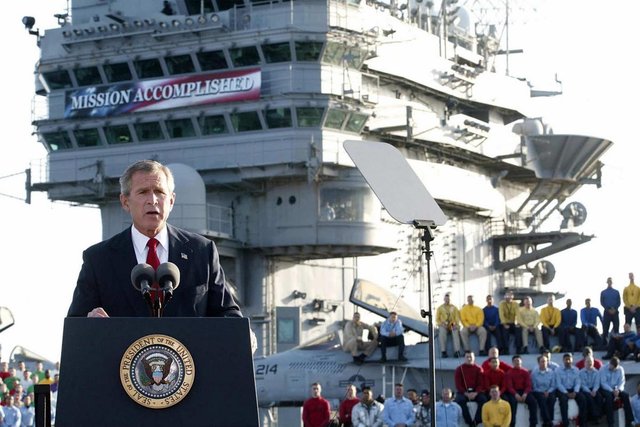
George W. Bush declares “Mission Accomplished” in Iraq
In Iraq, as troops drew down, there were some calls here in the US to do more than just leave. An idea was floated, sometimes called the Iraqi Dividend, that we should help set up a system to ensure that the people of Iraq would be financially supported as they rebuilt their worlds. It involved creating a sovereign wealth fund that would return to every Iraqi citizen a share of the country’s considerable oil profits. This would be a dividend not for the government to spend nor the owners of corporations nor foreign interests to pad their profits, but instead a dividend directly for the people, each and every one in equal share. The idea came and went; some say it was squashed, with differing ideas about by whom. Regardless, what would the Middle East look like today if the Iraqi people had been given the chance to recover? Could this type of foreign policy have been employed elsewhere, too?
This idea of the Iraqi Dividend is a version of the idea of Universal Basic Income (UBI). Essentially, UBI is the assertion that every citizen deserves to have a secure financial floor — an income big enough to cover basic living expenses — guaranteed to them regardless of circumstances, including whether or not they are employed or able to find work. It presumes that dignity and a drive for higher purpose are inherent in most every human being and can flourish if those human beings are not forced to adapt to a life of scarcity and insecurity.
The film Deia and I are making is an investigation into the concept of UBI in America. We are setting up an experiment to give a diverse group of Americans $1,000 per month for two years, and we will document and share what they do with it. We seek an answer to the human nature questions that arise when people receive unconditional income. We want to find out what changes in a person’s life and behavior when fear of catastrophic failure is taken away, when the gun to the head that is the threat of poverty is holstered, when people know that no matter what happens they’re going to be able to have a roof, a bed, and a full belly to rely on as they face the challenges their lives present.
There are many strong arguments for why UBI would represent not only a far more humane and moral social system than we have now, but also a more efficient, thriving, and productive economic one. Here is a great essay to get you started if you’re curious. For now, I am only focusing on UBI’s power in the fight against hate. It seems to me that an unconditional floor of economic security for all could go a very long way in winning that fight.
So yes, we need UBI. We need it for Christians and atheists, for grandmothers, for brothers, for painters, for the sick, for the healthy, for those who work, for those who love, and for those who hate. UBI for neo-Nazis. UBI for KKK. UBI for the rich and for the poor. We need it for people. We must give people security. If they no longer feel they’re being left behind or replaced, they can forget their romantic fantasies of rising up in heroic force, they can join the new us, and we can all progress together. Meanwhile, the truly and historically dispossessed, oppressed, and disenfranchised of us will be able to further grow and strengthen themselves and their communities, to take another huge leap forward in overcoming the imbalances and injustices of centuries of disadvantage.
It takes a lot of love and courage to forgive and to aid, and it’s so much easier for me to preach this than for someone who has been repeatedly hurt to practice it. I don’t suggest that we should expect the victims of violence to do all the work, to be perfect angels and win the day with love and patience while they see their brothers and sisters hurt or killed daily. We can, however, achieve such progress together through a change in our system. That means we all have to open our eyes and step up in support of that change. We must mobilize for UBI, among other universal and egalitarian reforms. We can turn off the gas that fuels the flames of hate, and it doesn’t require a smackdown. It takes the turn of a rusty, old valve.
To my fellow impressionable young men, let’s not forget that Conan was a barbarian, Patrick Bateman was a psycho, and both were fictional. Leave your helmets and your shields and your mace and your bats behind. We can do so much better. If Conan’s wise old trainer asked me now what is best in life, I would reply: “to embrace and support your fellow human beings, to witness them prosper and heal, and to reap the rewards of a just, effective, and loving society.”
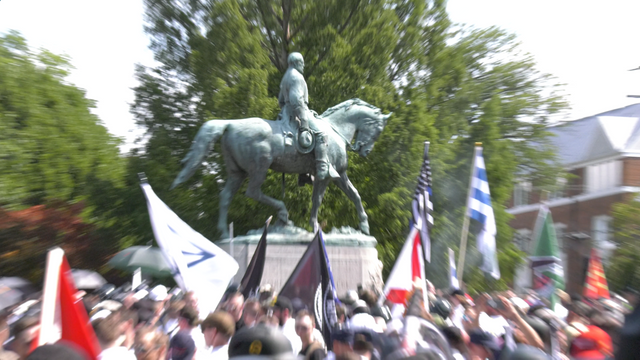
Congratulations @conradshaw! You received a personal award!
Click here to view your Board
Congratulations @conradshaw! You received a personal award!
You can view your badges on your Steem Board and compare to others on the Steem Ranking
Vote for @Steemitboard as a witness to get one more award and increased upvotes!